Analyzing Risk Management Strategies for New Technology Projects
VerifiedAdded on 2023/06/10
|17
|4465
|209
Report
AI Summary
This report critically analyzes the concept of risk from the perspective of a project manager and a business, particularly in the context of projects involving new technology. It evaluates how risk can be measured and ranked, outlining the construction of a project risk management strategy for an international team launching a new technology within six months. The report emphasizes the importance of risk management processes, including risk identification, analysis, evaluation, treatment, and monitoring. It considers the NSW solar plant project in Australia as a case study, highlighting the unique challenges and strategies for mitigating cost, schedule, resource, and technical risks. Effective collaboration and the use of risk management tools like risk matrices and registers are underscored as essential for successful project implementation and business sustainability, especially in complex international projects.
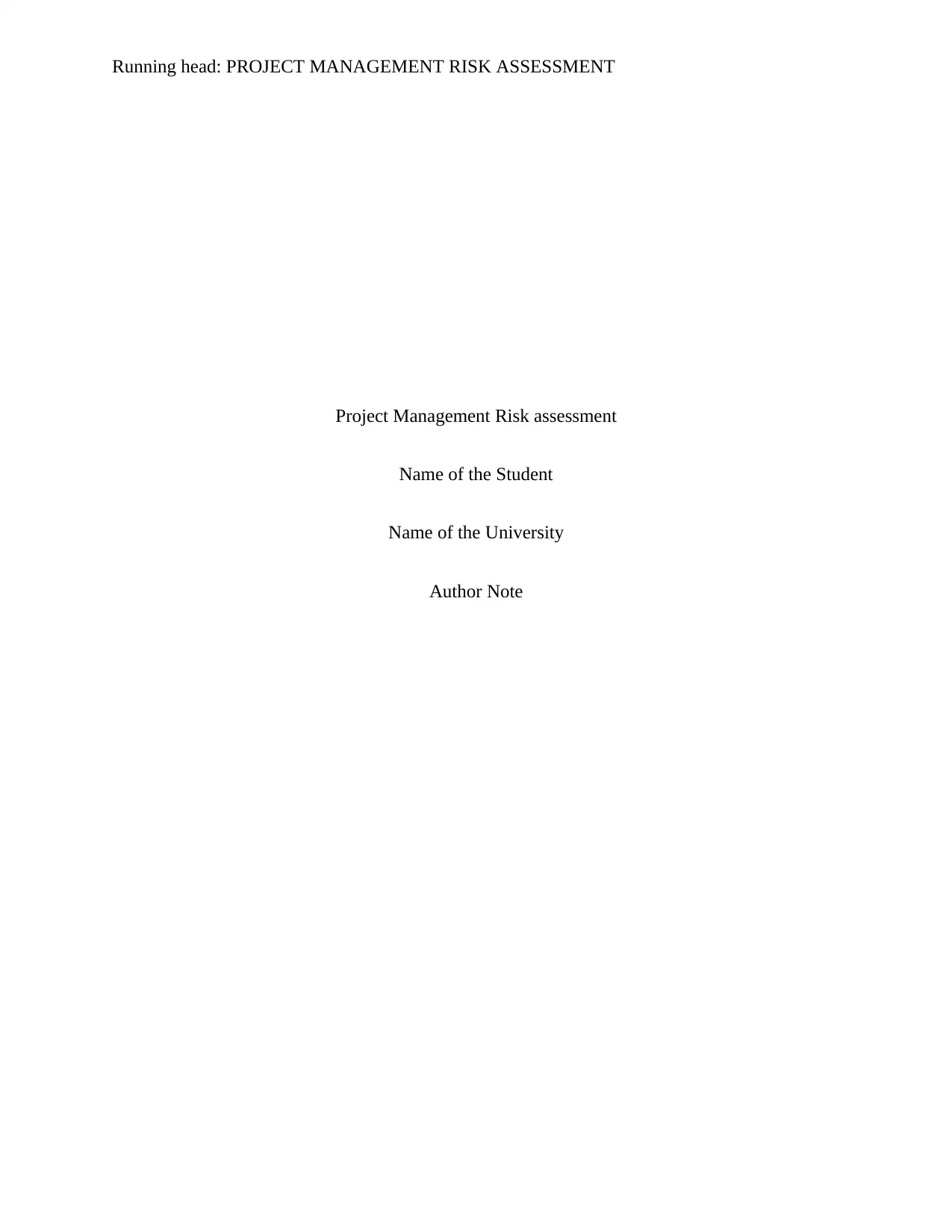
Running head: PROJECT MANAGEMENT RISK ASSESSMENT
Project Management Risk assessment
Name of the Student
Name of the University
Author Note
Project Management Risk assessment
Name of the Student
Name of the University
Author Note
Paraphrase This Document
Need a fresh take? Get an instant paraphrase of this document with our AI Paraphraser
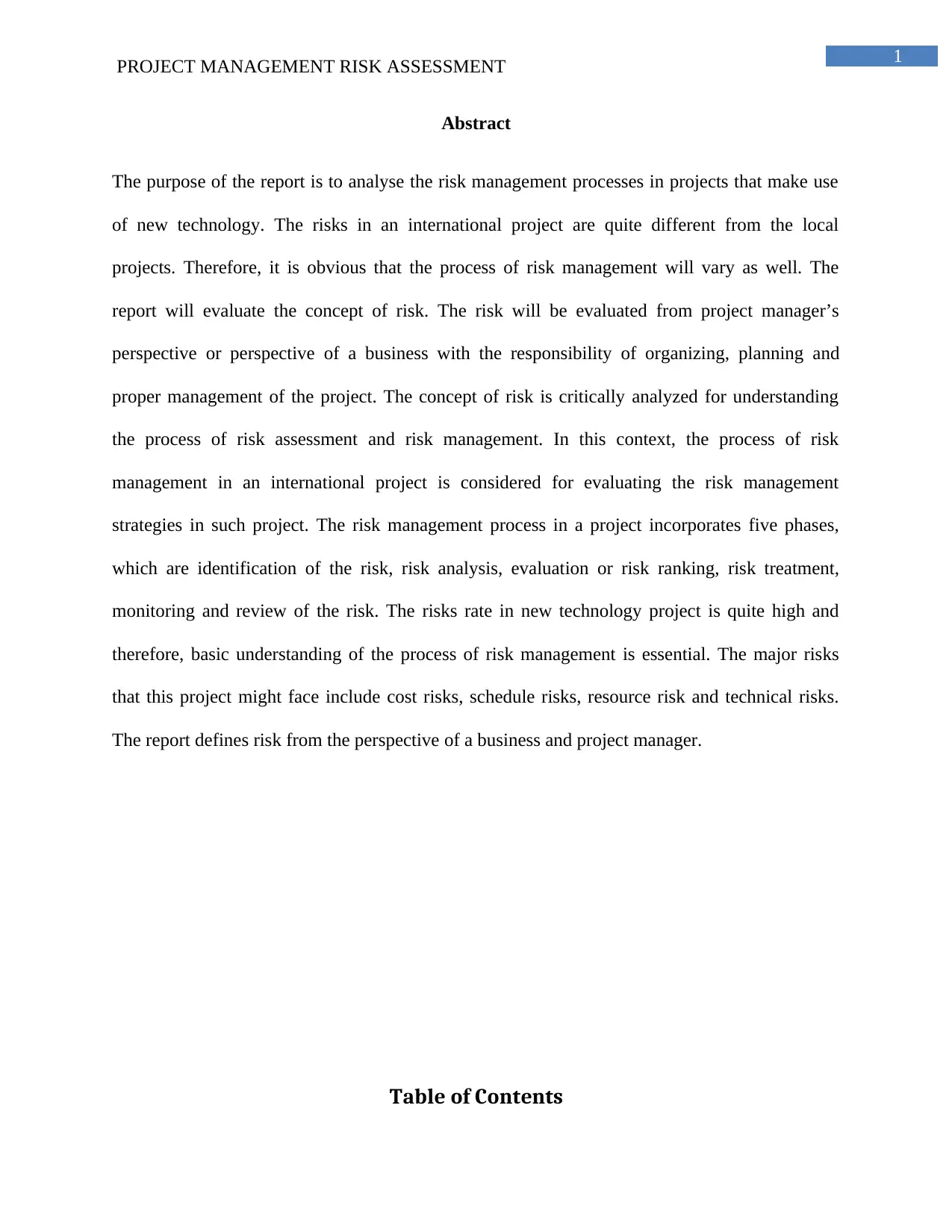
1
PROJECT MANAGEMENT RISK ASSESSMENT
Abstract
The purpose of the report is to analyse the risk management processes in projects that make use
of new technology. The risks in an international project are quite different from the local
projects. Therefore, it is obvious that the process of risk management will vary as well. The
report will evaluate the concept of risk. The risk will be evaluated from project manager’s
perspective or perspective of a business with the responsibility of organizing, planning and
proper management of the project. The concept of risk is critically analyzed for understanding
the process of risk assessment and risk management. In this context, the process of risk
management in an international project is considered for evaluating the risk management
strategies in such project. The risk management process in a project incorporates five phases,
which are identification of the risk, risk analysis, evaluation or risk ranking, risk treatment,
monitoring and review of the risk. The risks rate in new technology project is quite high and
therefore, basic understanding of the process of risk management is essential. The major risks
that this project might face include cost risks, schedule risks, resource risk and technical risks.
The report defines risk from the perspective of a business and project manager.
Table of Contents
PROJECT MANAGEMENT RISK ASSESSMENT
Abstract
The purpose of the report is to analyse the risk management processes in projects that make use
of new technology. The risks in an international project are quite different from the local
projects. Therefore, it is obvious that the process of risk management will vary as well. The
report will evaluate the concept of risk. The risk will be evaluated from project manager’s
perspective or perspective of a business with the responsibility of organizing, planning and
proper management of the project. The concept of risk is critically analyzed for understanding
the process of risk assessment and risk management. In this context, the process of risk
management in an international project is considered for evaluating the risk management
strategies in such project. The risk management process in a project incorporates five phases,
which are identification of the risk, risk analysis, evaluation or risk ranking, risk treatment,
monitoring and review of the risk. The risks rate in new technology project is quite high and
therefore, basic understanding of the process of risk management is essential. The major risks
that this project might face include cost risks, schedule risks, resource risk and technical risks.
The report defines risk from the perspective of a business and project manager.
Table of Contents
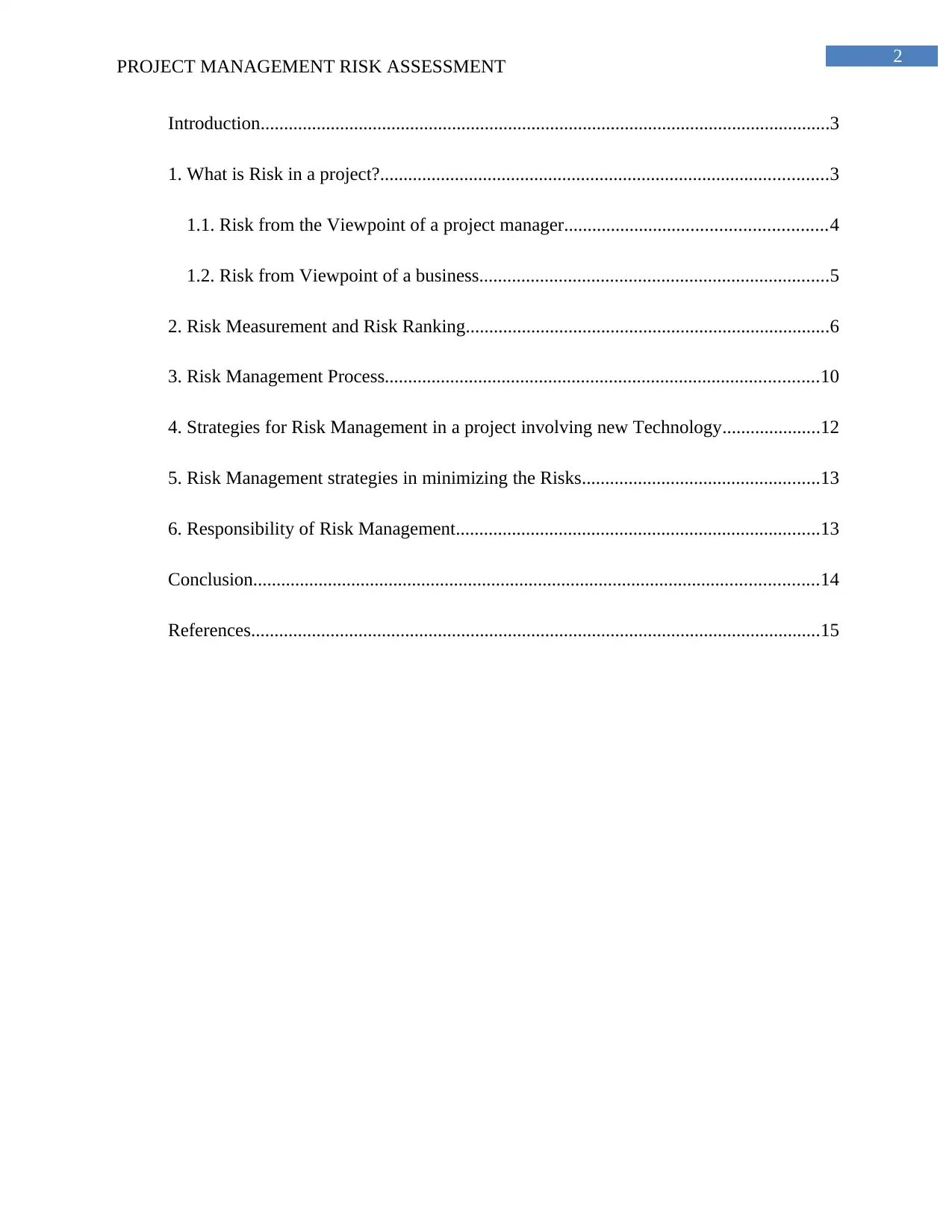
2
PROJECT MANAGEMENT RISK ASSESSMENT
Introduction..........................................................................................................................3
1. What is Risk in a project?................................................................................................3
1.1. Risk from the Viewpoint of a project manager........................................................4
1.2. Risk from Viewpoint of a business...........................................................................5
2. Risk Measurement and Risk Ranking..............................................................................6
3. Risk Management Process.............................................................................................10
4. Strategies for Risk Management in a project involving new Technology.....................12
5. Risk Management strategies in minimizing the Risks...................................................13
6. Responsibility of Risk Management..............................................................................13
Conclusion.........................................................................................................................14
References..........................................................................................................................15
PROJECT MANAGEMENT RISK ASSESSMENT
Introduction..........................................................................................................................3
1. What is Risk in a project?................................................................................................3
1.1. Risk from the Viewpoint of a project manager........................................................4
1.2. Risk from Viewpoint of a business...........................................................................5
2. Risk Measurement and Risk Ranking..............................................................................6
3. Risk Management Process.............................................................................................10
4. Strategies for Risk Management in a project involving new Technology.....................12
5. Risk Management strategies in minimizing the Risks...................................................13
6. Responsibility of Risk Management..............................................................................13
Conclusion.........................................................................................................................14
References..........................................................................................................................15
⊘ This is a preview!⊘
Do you want full access?
Subscribe today to unlock all pages.

Trusted by 1+ million students worldwide
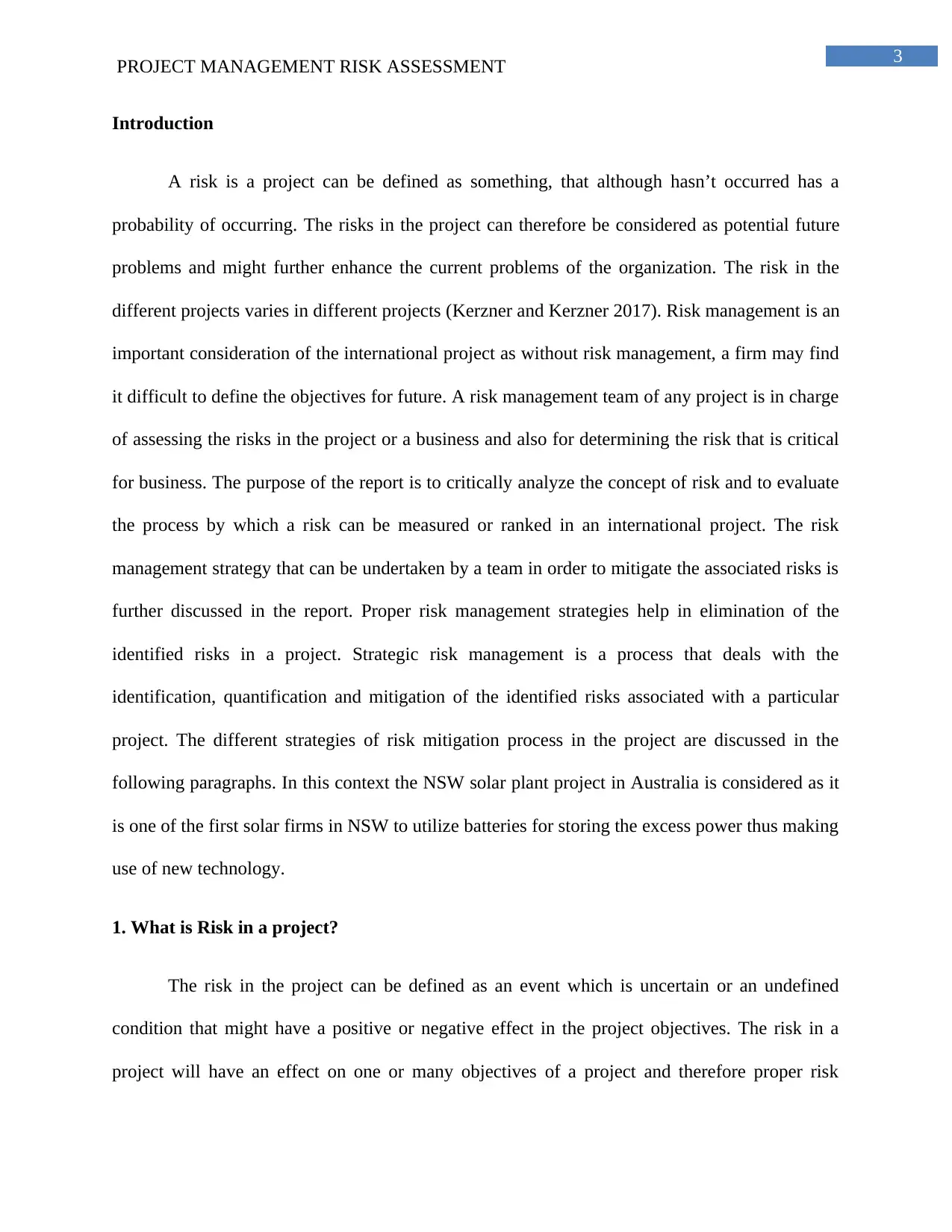
3
PROJECT MANAGEMENT RISK ASSESSMENT
Introduction
A risk is a project can be defined as something, that although hasn’t occurred has a
probability of occurring. The risks in the project can therefore be considered as potential future
problems and might further enhance the current problems of the organization. The risk in the
different projects varies in different projects (Kerzner and Kerzner 2017). Risk management is an
important consideration of the international project as without risk management, a firm may find
it difficult to define the objectives for future. A risk management team of any project is in charge
of assessing the risks in the project or a business and also for determining the risk that is critical
for business. The purpose of the report is to critically analyze the concept of risk and to evaluate
the process by which a risk can be measured or ranked in an international project. The risk
management strategy that can be undertaken by a team in order to mitigate the associated risks is
further discussed in the report. Proper risk management strategies help in elimination of the
identified risks in a project. Strategic risk management is a process that deals with the
identification, quantification and mitigation of the identified risks associated with a particular
project. The different strategies of risk mitigation process in the project are discussed in the
following paragraphs. In this context the NSW solar plant project in Australia is considered as it
is one of the first solar firms in NSW to utilize batteries for storing the excess power thus making
use of new technology.
1. What is Risk in a project?
The risk in the project can be defined as an event which is uncertain or an undefined
condition that might have a positive or negative effect in the project objectives. The risk in a
project will have an effect on one or many objectives of a project and therefore proper risk
PROJECT MANAGEMENT RISK ASSESSMENT
Introduction
A risk is a project can be defined as something, that although hasn’t occurred has a
probability of occurring. The risks in the project can therefore be considered as potential future
problems and might further enhance the current problems of the organization. The risk in the
different projects varies in different projects (Kerzner and Kerzner 2017). Risk management is an
important consideration of the international project as without risk management, a firm may find
it difficult to define the objectives for future. A risk management team of any project is in charge
of assessing the risks in the project or a business and also for determining the risk that is critical
for business. The purpose of the report is to critically analyze the concept of risk and to evaluate
the process by which a risk can be measured or ranked in an international project. The risk
management strategy that can be undertaken by a team in order to mitigate the associated risks is
further discussed in the report. Proper risk management strategies help in elimination of the
identified risks in a project. Strategic risk management is a process that deals with the
identification, quantification and mitigation of the identified risks associated with a particular
project. The different strategies of risk mitigation process in the project are discussed in the
following paragraphs. In this context the NSW solar plant project in Australia is considered as it
is one of the first solar firms in NSW to utilize batteries for storing the excess power thus making
use of new technology.
1. What is Risk in a project?
The risk in the project can be defined as an event which is uncertain or an undefined
condition that might have a positive or negative effect in the project objectives. The risk in a
project will have an effect on one or many objectives of a project and therefore proper risk
Paraphrase This Document
Need a fresh take? Get an instant paraphrase of this document with our AI Paraphraser
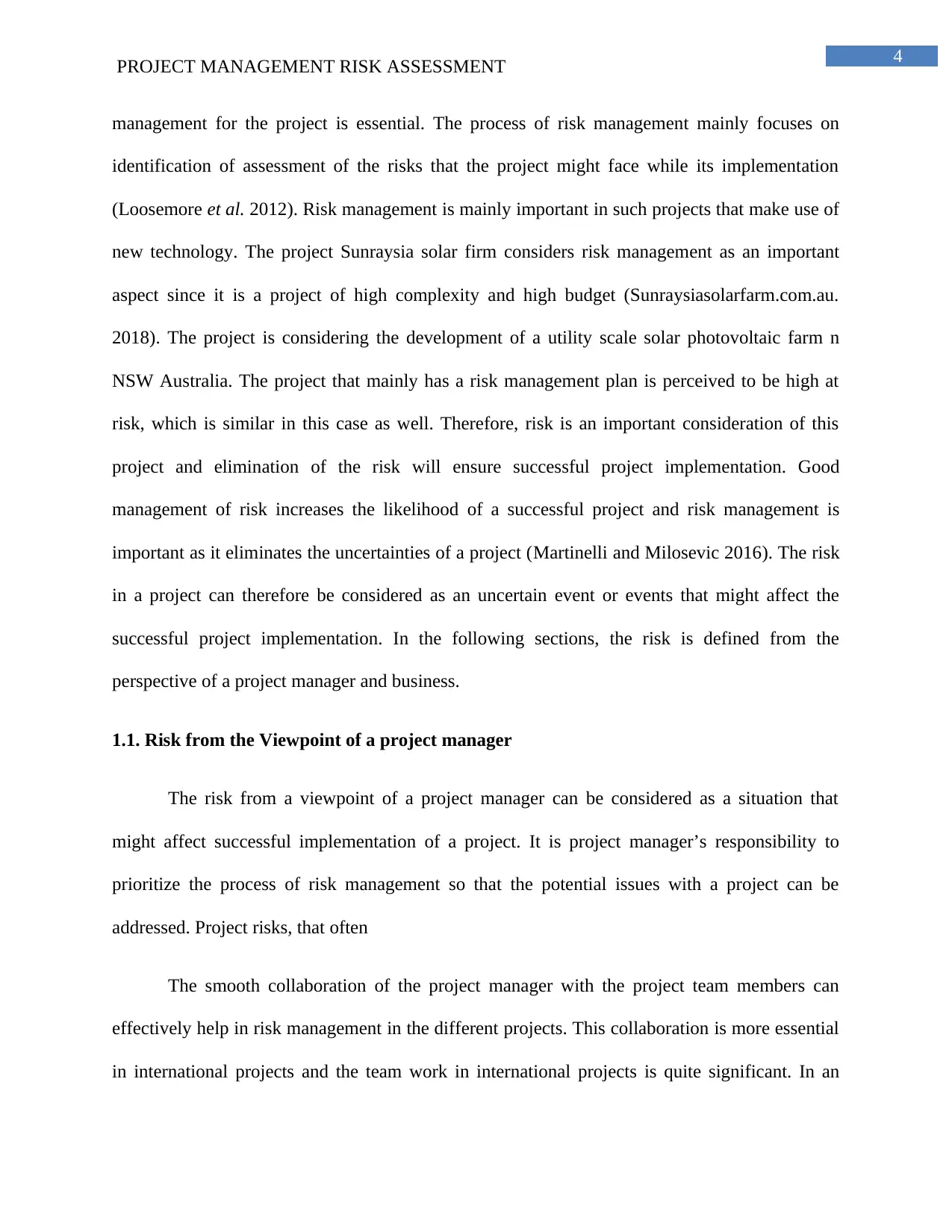
4
PROJECT MANAGEMENT RISK ASSESSMENT
management for the project is essential. The process of risk management mainly focuses on
identification of assessment of the risks that the project might face while its implementation
(Loosemore et al. 2012). Risk management is mainly important in such projects that make use of
new technology. The project Sunraysia solar firm considers risk management as an important
aspect since it is a project of high complexity and high budget (Sunraysiasolarfarm.com.au.
2018). The project is considering the development of a utility scale solar photovoltaic farm n
NSW Australia. The project that mainly has a risk management plan is perceived to be high at
risk, which is similar in this case as well. Therefore, risk is an important consideration of this
project and elimination of the risk will ensure successful project implementation. Good
management of risk increases the likelihood of a successful project and risk management is
important as it eliminates the uncertainties of a project (Martinelli and Milosevic 2016). The risk
in a project can therefore be considered as an uncertain event or events that might affect the
successful project implementation. In the following sections, the risk is defined from the
perspective of a project manager and business.
1.1. Risk from the Viewpoint of a project manager
The risk from a viewpoint of a project manager can be considered as a situation that
might affect successful implementation of a project. It is project manager’s responsibility to
prioritize the process of risk management so that the potential issues with a project can be
addressed. Project risks, that often
The smooth collaboration of the project manager with the project team members can
effectively help in risk management in the different projects. This collaboration is more essential
in international projects and the team work in international projects is quite significant. In an
PROJECT MANAGEMENT RISK ASSESSMENT
management for the project is essential. The process of risk management mainly focuses on
identification of assessment of the risks that the project might face while its implementation
(Loosemore et al. 2012). Risk management is mainly important in such projects that make use of
new technology. The project Sunraysia solar firm considers risk management as an important
aspect since it is a project of high complexity and high budget (Sunraysiasolarfarm.com.au.
2018). The project is considering the development of a utility scale solar photovoltaic farm n
NSW Australia. The project that mainly has a risk management plan is perceived to be high at
risk, which is similar in this case as well. Therefore, risk is an important consideration of this
project and elimination of the risk will ensure successful project implementation. Good
management of risk increases the likelihood of a successful project and risk management is
important as it eliminates the uncertainties of a project (Martinelli and Milosevic 2016). The risk
in a project can therefore be considered as an uncertain event or events that might affect the
successful project implementation. In the following sections, the risk is defined from the
perspective of a project manager and business.
1.1. Risk from the Viewpoint of a project manager
The risk from a viewpoint of a project manager can be considered as a situation that
might affect successful implementation of a project. It is project manager’s responsibility to
prioritize the process of risk management so that the potential issues with a project can be
addressed. Project risks, that often
The smooth collaboration of the project manager with the project team members can
effectively help in risk management in the different projects. This collaboration is more essential
in international projects and the team work in international projects is quite significant. In an
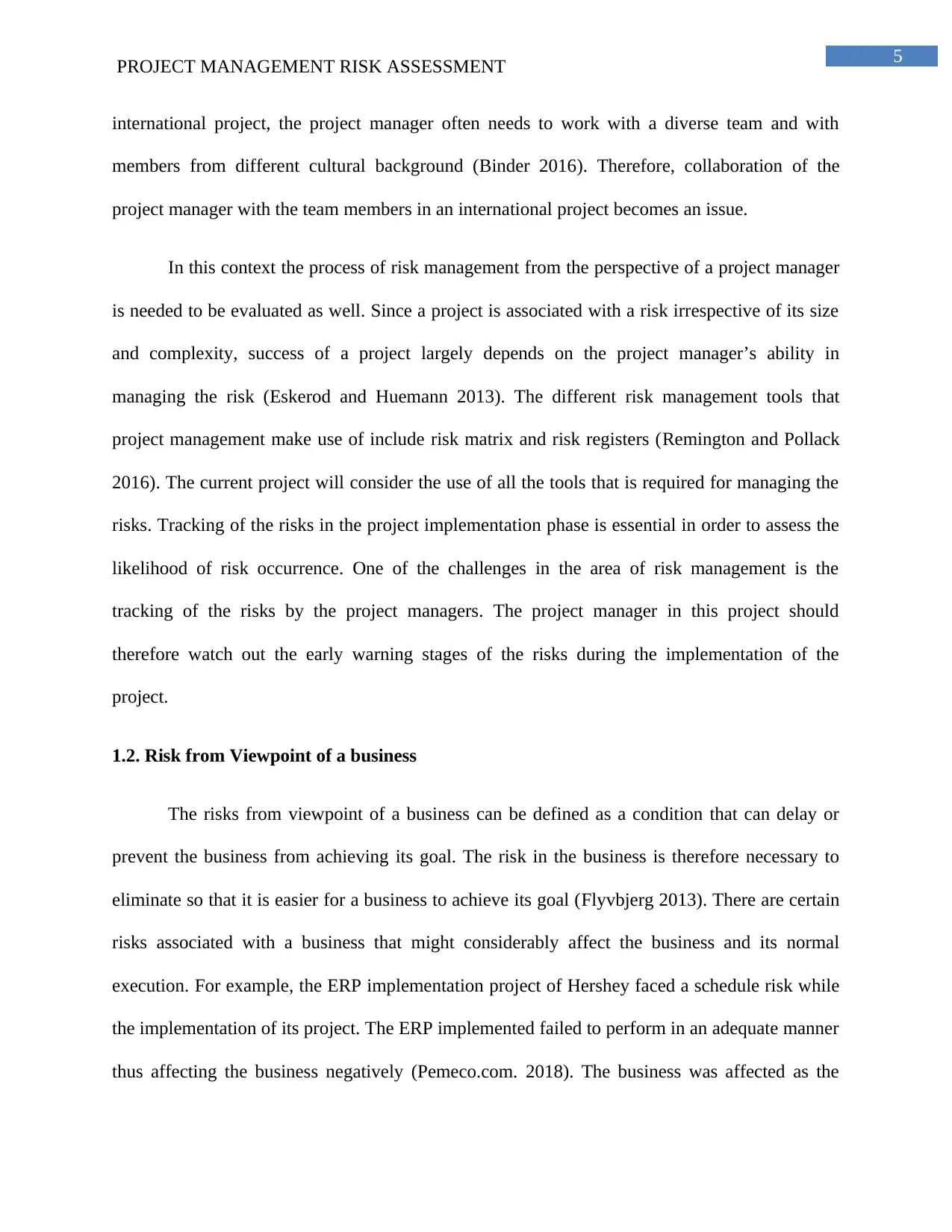
5
PROJECT MANAGEMENT RISK ASSESSMENT
international project, the project manager often needs to work with a diverse team and with
members from different cultural background (Binder 2016). Therefore, collaboration of the
project manager with the team members in an international project becomes an issue.
In this context the process of risk management from the perspective of a project manager
is needed to be evaluated as well. Since a project is associated with a risk irrespective of its size
and complexity, success of a project largely depends on the project manager’s ability in
managing the risk (Eskerod and Huemann 2013). The different risk management tools that
project management make use of include risk matrix and risk registers (Remington and Pollack
2016). The current project will consider the use of all the tools that is required for managing the
risks. Tracking of the risks in the project implementation phase is essential in order to assess the
likelihood of risk occurrence. One of the challenges in the area of risk management is the
tracking of the risks by the project managers. The project manager in this project should
therefore watch out the early warning stages of the risks during the implementation of the
project.
1.2. Risk from Viewpoint of a business
The risks from viewpoint of a business can be defined as a condition that can delay or
prevent the business from achieving its goal. The risk in the business is therefore necessary to
eliminate so that it is easier for a business to achieve its goal (Flyvbjerg 2013). There are certain
risks associated with a business that might considerably affect the business and its normal
execution. For example, the ERP implementation project of Hershey faced a schedule risk while
the implementation of its project. The ERP implemented failed to perform in an adequate manner
thus affecting the business negatively (Pemeco.com. 2018). The business was affected as the
PROJECT MANAGEMENT RISK ASSESSMENT
international project, the project manager often needs to work with a diverse team and with
members from different cultural background (Binder 2016). Therefore, collaboration of the
project manager with the team members in an international project becomes an issue.
In this context the process of risk management from the perspective of a project manager
is needed to be evaluated as well. Since a project is associated with a risk irrespective of its size
and complexity, success of a project largely depends on the project manager’s ability in
managing the risk (Eskerod and Huemann 2013). The different risk management tools that
project management make use of include risk matrix and risk registers (Remington and Pollack
2016). The current project will consider the use of all the tools that is required for managing the
risks. Tracking of the risks in the project implementation phase is essential in order to assess the
likelihood of risk occurrence. One of the challenges in the area of risk management is the
tracking of the risks by the project managers. The project manager in this project should
therefore watch out the early warning stages of the risks during the implementation of the
project.
1.2. Risk from Viewpoint of a business
The risks from viewpoint of a business can be defined as a condition that can delay or
prevent the business from achieving its goal. The risk in the business is therefore necessary to
eliminate so that it is easier for a business to achieve its goal (Flyvbjerg 2013). There are certain
risks associated with a business that might considerably affect the business and its normal
execution. For example, the ERP implementation project of Hershey faced a schedule risk while
the implementation of its project. The ERP implemented failed to perform in an adequate manner
thus affecting the business negatively (Pemeco.com. 2018). The business was affected as the
⊘ This is a preview!⊘
Do you want full access?
Subscribe today to unlock all pages.

Trusted by 1+ million students worldwide
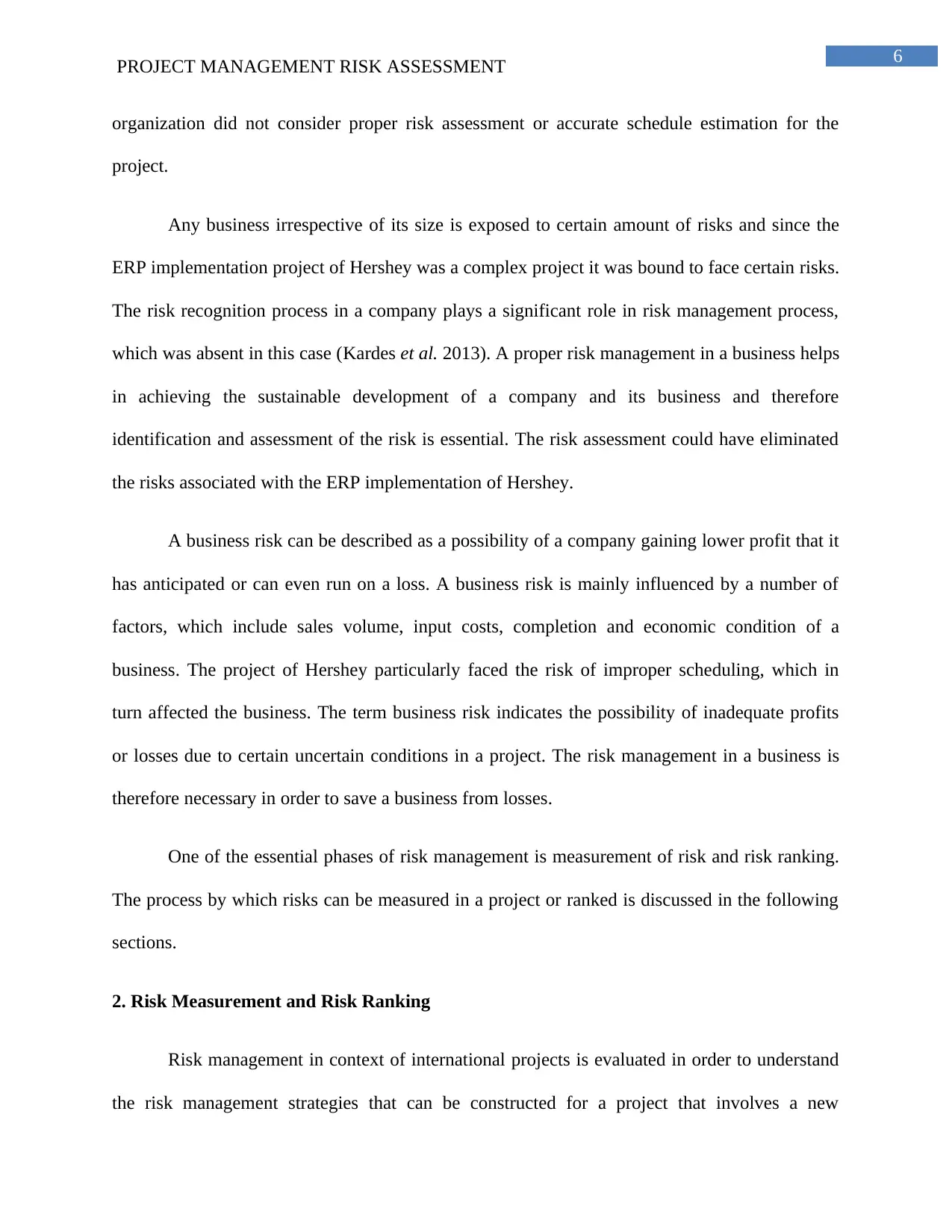
6
PROJECT MANAGEMENT RISK ASSESSMENT
organization did not consider proper risk assessment or accurate schedule estimation for the
project.
Any business irrespective of its size is exposed to certain amount of risks and since the
ERP implementation project of Hershey was a complex project it was bound to face certain risks.
The risk recognition process in a company plays a significant role in risk management process,
which was absent in this case (Kardes et al. 2013). A proper risk management in a business helps
in achieving the sustainable development of a company and its business and therefore
identification and assessment of the risk is essential. The risk assessment could have eliminated
the risks associated with the ERP implementation of Hershey.
A business risk can be described as a possibility of a company gaining lower profit that it
has anticipated or can even run on a loss. A business risk is mainly influenced by a number of
factors, which include sales volume, input costs, completion and economic condition of a
business. The project of Hershey particularly faced the risk of improper scheduling, which in
turn affected the business. The term business risk indicates the possibility of inadequate profits
or losses due to certain uncertain conditions in a project. The risk management in a business is
therefore necessary in order to save a business from losses.
One of the essential phases of risk management is measurement of risk and risk ranking.
The process by which risks can be measured in a project or ranked is discussed in the following
sections.
2. Risk Measurement and Risk Ranking
Risk management in context of international projects is evaluated in order to understand
the risk management strategies that can be constructed for a project that involves a new
PROJECT MANAGEMENT RISK ASSESSMENT
organization did not consider proper risk assessment or accurate schedule estimation for the
project.
Any business irrespective of its size is exposed to certain amount of risks and since the
ERP implementation project of Hershey was a complex project it was bound to face certain risks.
The risk recognition process in a company plays a significant role in risk management process,
which was absent in this case (Kardes et al. 2013). A proper risk management in a business helps
in achieving the sustainable development of a company and its business and therefore
identification and assessment of the risk is essential. The risk assessment could have eliminated
the risks associated with the ERP implementation of Hershey.
A business risk can be described as a possibility of a company gaining lower profit that it
has anticipated or can even run on a loss. A business risk is mainly influenced by a number of
factors, which include sales volume, input costs, completion and economic condition of a
business. The project of Hershey particularly faced the risk of improper scheduling, which in
turn affected the business. The term business risk indicates the possibility of inadequate profits
or losses due to certain uncertain conditions in a project. The risk management in a business is
therefore necessary in order to save a business from losses.
One of the essential phases of risk management is measurement of risk and risk ranking.
The process by which risks can be measured in a project or ranked is discussed in the following
sections.
2. Risk Measurement and Risk Ranking
Risk management in context of international projects is evaluated in order to understand
the risk management strategies that can be constructed for a project that involves a new
Paraphrase This Document
Need a fresh take? Get an instant paraphrase of this document with our AI Paraphraser
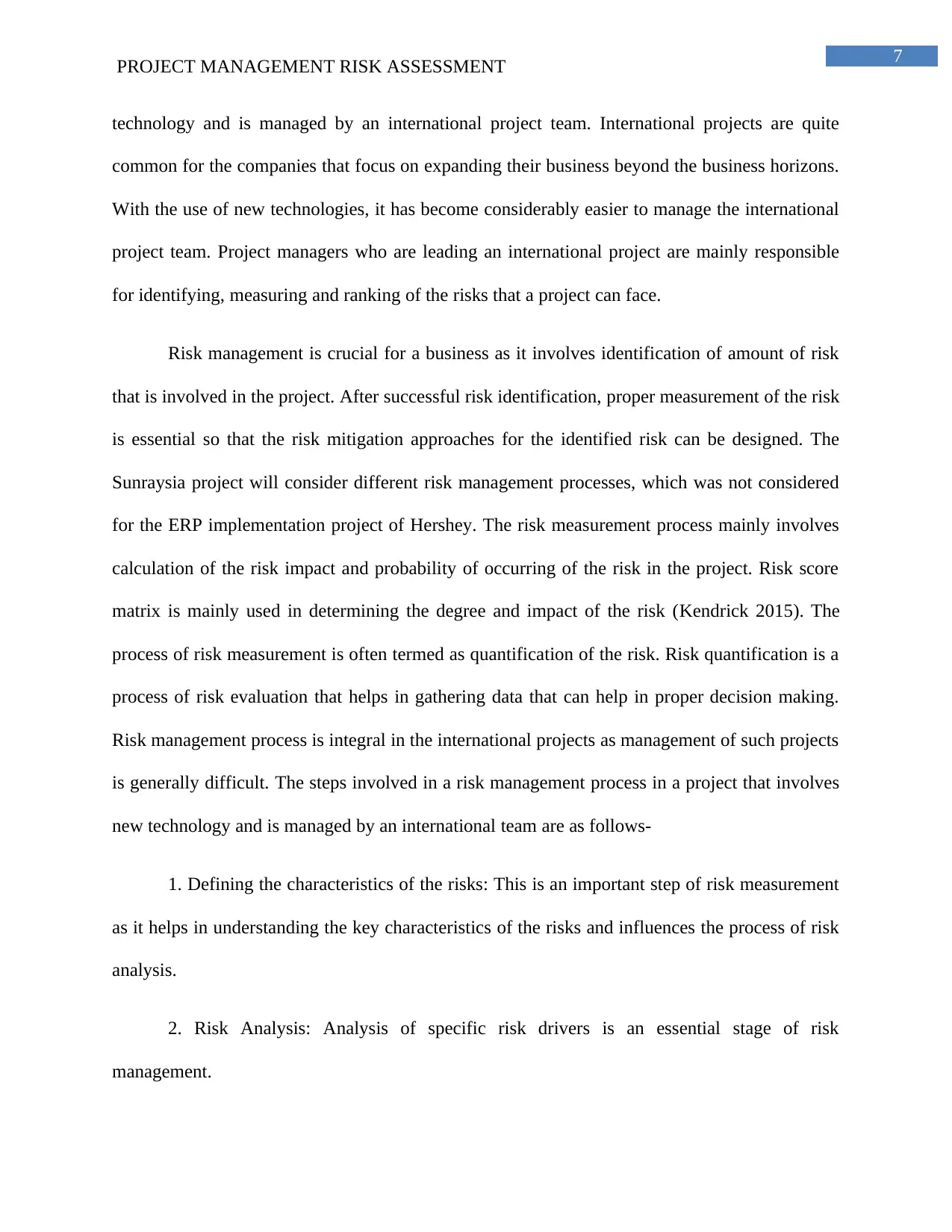
7
PROJECT MANAGEMENT RISK ASSESSMENT
technology and is managed by an international project team. International projects are quite
common for the companies that focus on expanding their business beyond the business horizons.
With the use of new technologies, it has become considerably easier to manage the international
project team. Project managers who are leading an international project are mainly responsible
for identifying, measuring and ranking of the risks that a project can face.
Risk management is crucial for a business as it involves identification of amount of risk
that is involved in the project. After successful risk identification, proper measurement of the risk
is essential so that the risk mitigation approaches for the identified risk can be designed. The
Sunraysia project will consider different risk management processes, which was not considered
for the ERP implementation project of Hershey. The risk measurement process mainly involves
calculation of the risk impact and probability of occurring of the risk in the project. Risk score
matrix is mainly used in determining the degree and impact of the risk (Kendrick 2015). The
process of risk measurement is often termed as quantification of the risk. Risk quantification is a
process of risk evaluation that helps in gathering data that can help in proper decision making.
Risk management process is integral in the international projects as management of such projects
is generally difficult. The steps involved in a risk management process in a project that involves
new technology and is managed by an international team are as follows-
1. Defining the characteristics of the risks: This is an important step of risk measurement
as it helps in understanding the key characteristics of the risks and influences the process of risk
analysis.
2. Risk Analysis: Analysis of specific risk drivers is an essential stage of risk
management.
PROJECT MANAGEMENT RISK ASSESSMENT
technology and is managed by an international project team. International projects are quite
common for the companies that focus on expanding their business beyond the business horizons.
With the use of new technologies, it has become considerably easier to manage the international
project team. Project managers who are leading an international project are mainly responsible
for identifying, measuring and ranking of the risks that a project can face.
Risk management is crucial for a business as it involves identification of amount of risk
that is involved in the project. After successful risk identification, proper measurement of the risk
is essential so that the risk mitigation approaches for the identified risk can be designed. The
Sunraysia project will consider different risk management processes, which was not considered
for the ERP implementation project of Hershey. The risk measurement process mainly involves
calculation of the risk impact and probability of occurring of the risk in the project. Risk score
matrix is mainly used in determining the degree and impact of the risk (Kendrick 2015). The
process of risk measurement is often termed as quantification of the risk. Risk quantification is a
process of risk evaluation that helps in gathering data that can help in proper decision making.
Risk management process is integral in the international projects as management of such projects
is generally difficult. The steps involved in a risk management process in a project that involves
new technology and is managed by an international team are as follows-
1. Defining the characteristics of the risks: This is an important step of risk measurement
as it helps in understanding the key characteristics of the risks and influences the process of risk
analysis.
2. Risk Analysis: Analysis of specific risk drivers is an essential stage of risk
management.
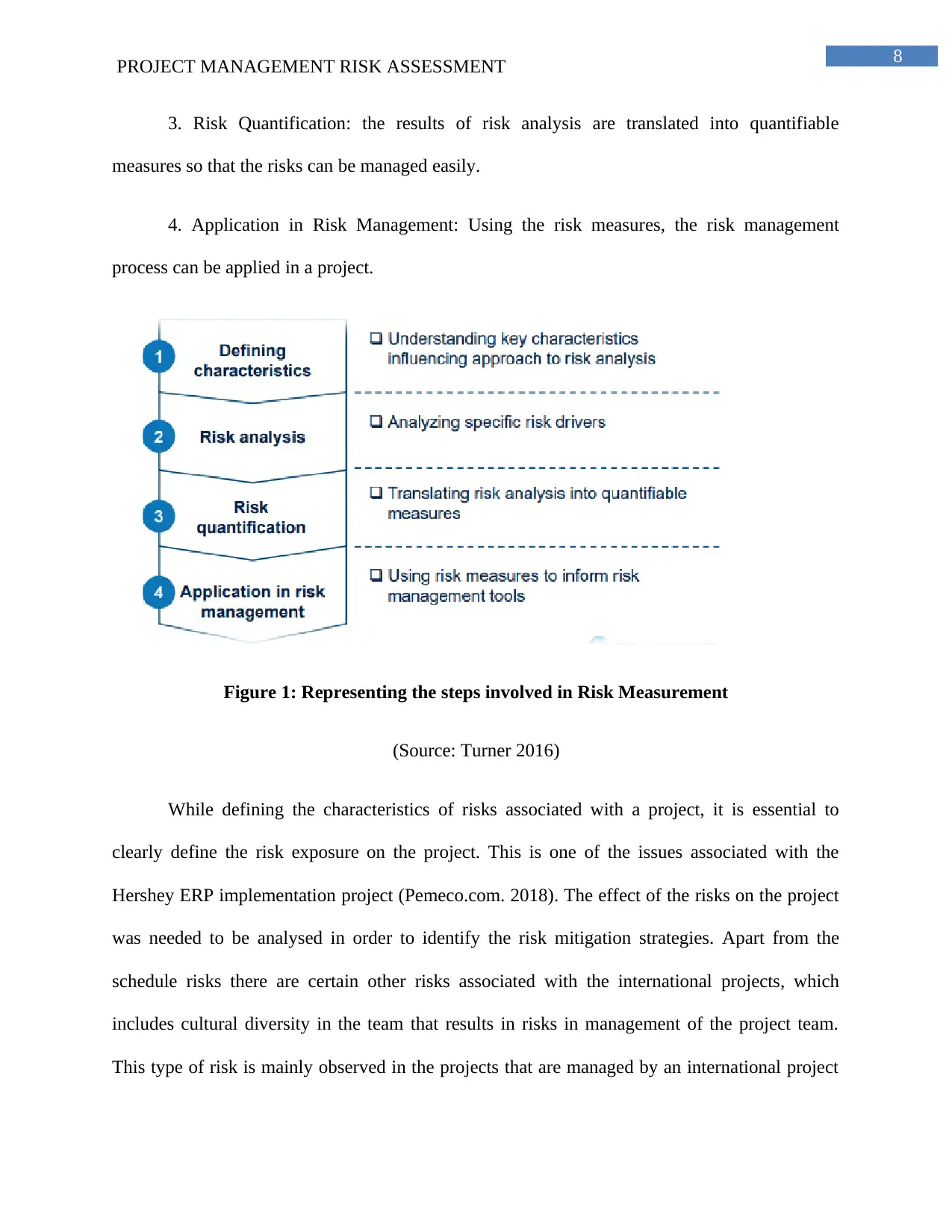
8
PROJECT MANAGEMENT RISK ASSESSMENT
3. Risk Quantification: the results of risk analysis are translated into quantifiable
measures so that the risks can be managed easily.
4. Application in Risk Management: Using the risk measures, the risk management
process can be applied in a project.
Figure 1: Representing the steps involved in Risk Measurement
(Source: Turner 2016)
While defining the characteristics of risks associated with a project, it is essential to
clearly define the risk exposure on the project. This is one of the issues associated with the
Hershey ERP implementation project (Pemeco.com. 2018). The effect of the risks on the project
was needed to be analysed in order to identify the risk mitigation strategies. Apart from the
schedule risks there are certain other risks associated with the international projects, which
includes cultural diversity in the team that results in risks in management of the project team.
This type of risk is mainly observed in the projects that are managed by an international project
PROJECT MANAGEMENT RISK ASSESSMENT
3. Risk Quantification: the results of risk analysis are translated into quantifiable
measures so that the risks can be managed easily.
4. Application in Risk Management: Using the risk measures, the risk management
process can be applied in a project.
Figure 1: Representing the steps involved in Risk Measurement
(Source: Turner 2016)
While defining the characteristics of risks associated with a project, it is essential to
clearly define the risk exposure on the project. This is one of the issues associated with the
Hershey ERP implementation project (Pemeco.com. 2018). The effect of the risks on the project
was needed to be analysed in order to identify the risk mitigation strategies. Apart from the
schedule risks there are certain other risks associated with the international projects, which
includes cultural diversity in the team that results in risks in management of the project team.
This type of risk is mainly observed in the projects that are managed by an international project
⊘ This is a preview!⊘
Do you want full access?
Subscribe today to unlock all pages.

Trusted by 1+ million students worldwide
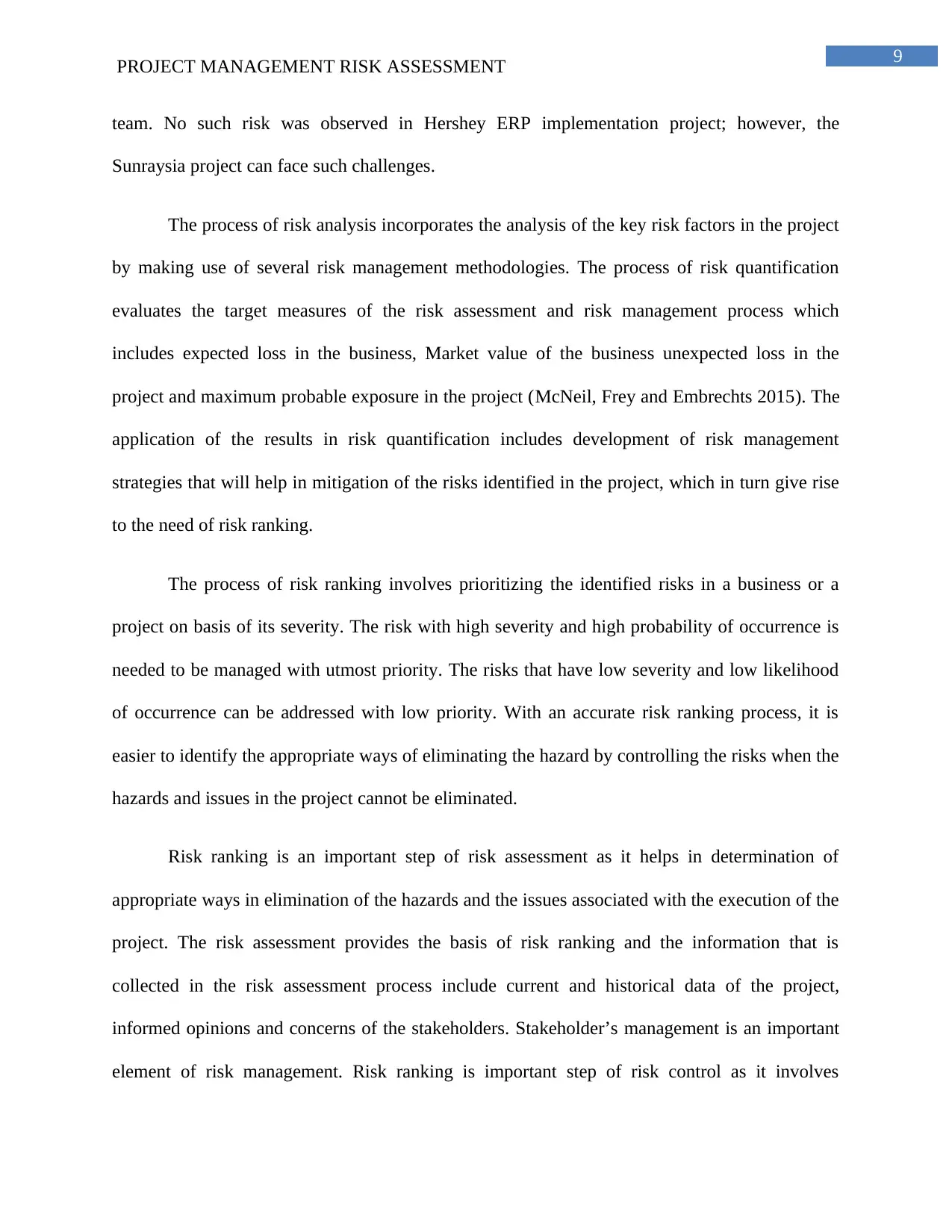
9
PROJECT MANAGEMENT RISK ASSESSMENT
team. No such risk was observed in Hershey ERP implementation project; however, the
Sunraysia project can face such challenges.
The process of risk analysis incorporates the analysis of the key risk factors in the project
by making use of several risk management methodologies. The process of risk quantification
evaluates the target measures of the risk assessment and risk management process which
includes expected loss in the business, Market value of the business unexpected loss in the
project and maximum probable exposure in the project (McNeil, Frey and Embrechts 2015). The
application of the results in risk quantification includes development of risk management
strategies that will help in mitigation of the risks identified in the project, which in turn give rise
to the need of risk ranking.
The process of risk ranking involves prioritizing the identified risks in a business or a
project on basis of its severity. The risk with high severity and high probability of occurrence is
needed to be managed with utmost priority. The risks that have low severity and low likelihood
of occurrence can be addressed with low priority. With an accurate risk ranking process, it is
easier to identify the appropriate ways of eliminating the hazard by controlling the risks when the
hazards and issues in the project cannot be eliminated.
Risk ranking is an important step of risk assessment as it helps in determination of
appropriate ways in elimination of the hazards and the issues associated with the execution of the
project. The risk assessment provides the basis of risk ranking and the information that is
collected in the risk assessment process include current and historical data of the project,
informed opinions and concerns of the stakeholders. Stakeholder’s management is an important
element of risk management. Risk ranking is important step of risk control as it involves
PROJECT MANAGEMENT RISK ASSESSMENT
team. No such risk was observed in Hershey ERP implementation project; however, the
Sunraysia project can face such challenges.
The process of risk analysis incorporates the analysis of the key risk factors in the project
by making use of several risk management methodologies. The process of risk quantification
evaluates the target measures of the risk assessment and risk management process which
includes expected loss in the business, Market value of the business unexpected loss in the
project and maximum probable exposure in the project (McNeil, Frey and Embrechts 2015). The
application of the results in risk quantification includes development of risk management
strategies that will help in mitigation of the risks identified in the project, which in turn give rise
to the need of risk ranking.
The process of risk ranking involves prioritizing the identified risks in a business or a
project on basis of its severity. The risk with high severity and high probability of occurrence is
needed to be managed with utmost priority. The risks that have low severity and low likelihood
of occurrence can be addressed with low priority. With an accurate risk ranking process, it is
easier to identify the appropriate ways of eliminating the hazard by controlling the risks when the
hazards and issues in the project cannot be eliminated.
Risk ranking is an important step of risk assessment as it helps in determination of
appropriate ways in elimination of the hazards and the issues associated with the execution of the
project. The risk assessment provides the basis of risk ranking and the information that is
collected in the risk assessment process include current and historical data of the project,
informed opinions and concerns of the stakeholders. Stakeholder’s management is an important
element of risk management. Risk ranking is important step of risk control as it involves
Paraphrase This Document
Need a fresh take? Get an instant paraphrase of this document with our AI Paraphraser
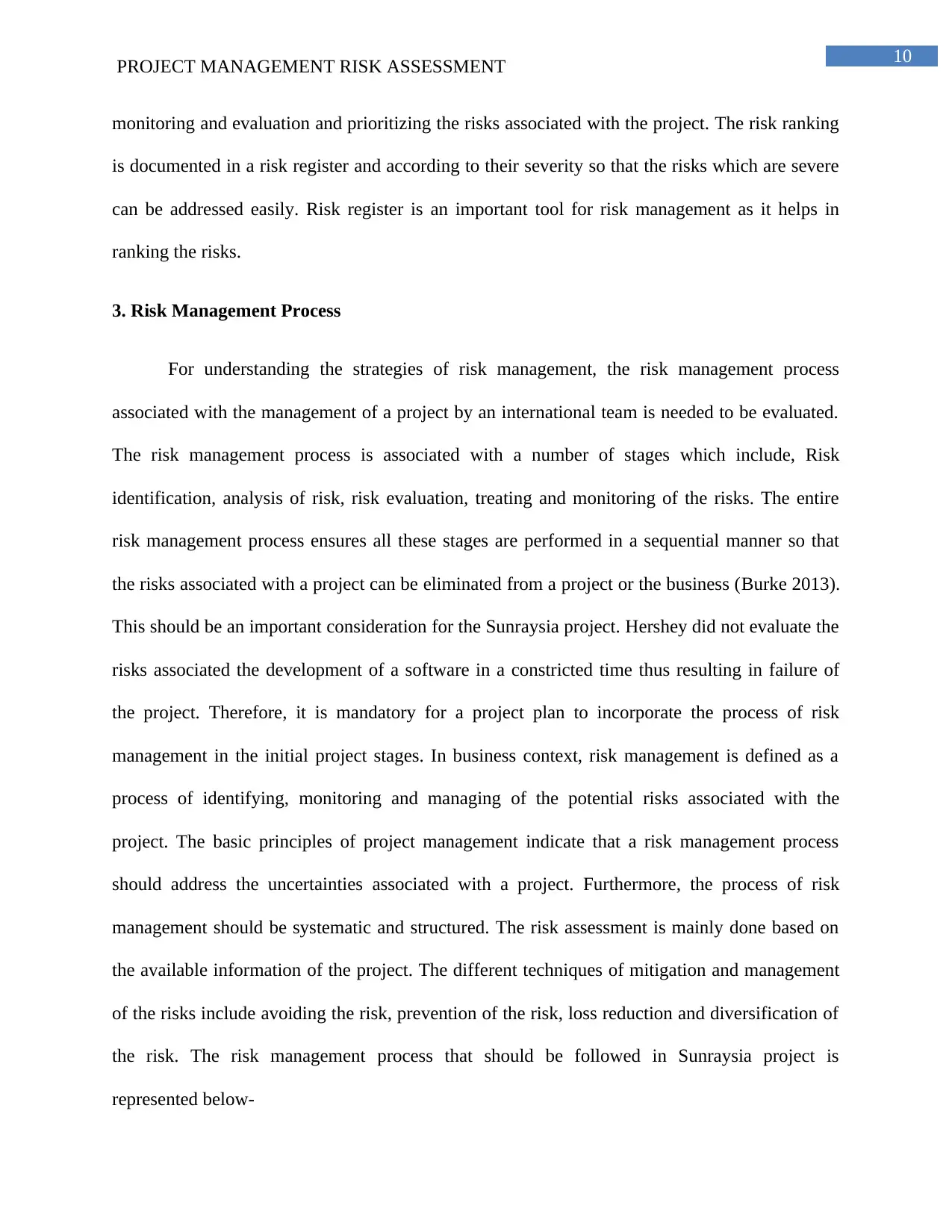
10
PROJECT MANAGEMENT RISK ASSESSMENT
monitoring and evaluation and prioritizing the risks associated with the project. The risk ranking
is documented in a risk register and according to their severity so that the risks which are severe
can be addressed easily. Risk register is an important tool for risk management as it helps in
ranking the risks.
3. Risk Management Process
For understanding the strategies of risk management, the risk management process
associated with the management of a project by an international team is needed to be evaluated.
The risk management process is associated with a number of stages which include, Risk
identification, analysis of risk, risk evaluation, treating and monitoring of the risks. The entire
risk management process ensures all these stages are performed in a sequential manner so that
the risks associated with a project can be eliminated from a project or the business (Burke 2013).
This should be an important consideration for the Sunraysia project. Hershey did not evaluate the
risks associated the development of a software in a constricted time thus resulting in failure of
the project. Therefore, it is mandatory for a project plan to incorporate the process of risk
management in the initial project stages. In business context, risk management is defined as a
process of identifying, monitoring and managing of the potential risks associated with the
project. The basic principles of project management indicate that a risk management process
should address the uncertainties associated with a project. Furthermore, the process of risk
management should be systematic and structured. The risk assessment is mainly done based on
the available information of the project. The different techniques of mitigation and management
of the risks include avoiding the risk, prevention of the risk, loss reduction and diversification of
the risk. The risk management process that should be followed in Sunraysia project is
represented below-
PROJECT MANAGEMENT RISK ASSESSMENT
monitoring and evaluation and prioritizing the risks associated with the project. The risk ranking
is documented in a risk register and according to their severity so that the risks which are severe
can be addressed easily. Risk register is an important tool for risk management as it helps in
ranking the risks.
3. Risk Management Process
For understanding the strategies of risk management, the risk management process
associated with the management of a project by an international team is needed to be evaluated.
The risk management process is associated with a number of stages which include, Risk
identification, analysis of risk, risk evaluation, treating and monitoring of the risks. The entire
risk management process ensures all these stages are performed in a sequential manner so that
the risks associated with a project can be eliminated from a project or the business (Burke 2013).
This should be an important consideration for the Sunraysia project. Hershey did not evaluate the
risks associated the development of a software in a constricted time thus resulting in failure of
the project. Therefore, it is mandatory for a project plan to incorporate the process of risk
management in the initial project stages. In business context, risk management is defined as a
process of identifying, monitoring and managing of the potential risks associated with the
project. The basic principles of project management indicate that a risk management process
should address the uncertainties associated with a project. Furthermore, the process of risk
management should be systematic and structured. The risk assessment is mainly done based on
the available information of the project. The different techniques of mitigation and management
of the risks include avoiding the risk, prevention of the risk, loss reduction and diversification of
the risk. The risk management process that should be followed in Sunraysia project is
represented below-
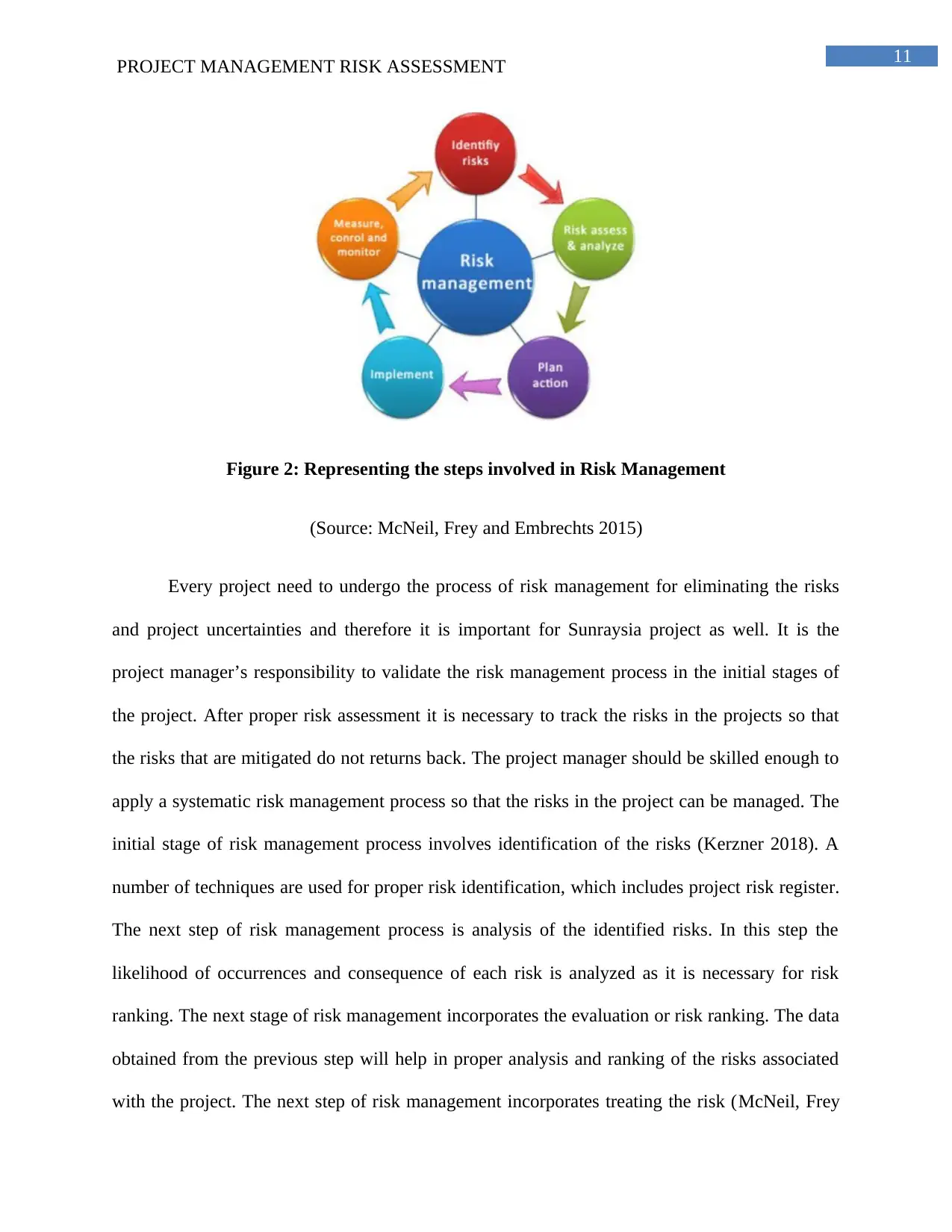
11
PROJECT MANAGEMENT RISK ASSESSMENT
Figure 2: Representing the steps involved in Risk Management
(Source: McNeil, Frey and Embrechts 2015)
Every project need to undergo the process of risk management for eliminating the risks
and project uncertainties and therefore it is important for Sunraysia project as well. It is the
project manager’s responsibility to validate the risk management process in the initial stages of
the project. After proper risk assessment it is necessary to track the risks in the projects so that
the risks that are mitigated do not returns back. The project manager should be skilled enough to
apply a systematic risk management process so that the risks in the project can be managed. The
initial stage of risk management process involves identification of the risks (Kerzner 2018). A
number of techniques are used for proper risk identification, which includes project risk register.
The next step of risk management process is analysis of the identified risks. In this step the
likelihood of occurrences and consequence of each risk is analyzed as it is necessary for risk
ranking. The next stage of risk management incorporates the evaluation or risk ranking. The data
obtained from the previous step will help in proper analysis and ranking of the risks associated
with the project. The next step of risk management incorporates treating the risk (McNeil, Frey
PROJECT MANAGEMENT RISK ASSESSMENT
Figure 2: Representing the steps involved in Risk Management
(Source: McNeil, Frey and Embrechts 2015)
Every project need to undergo the process of risk management for eliminating the risks
and project uncertainties and therefore it is important for Sunraysia project as well. It is the
project manager’s responsibility to validate the risk management process in the initial stages of
the project. After proper risk assessment it is necessary to track the risks in the projects so that
the risks that are mitigated do not returns back. The project manager should be skilled enough to
apply a systematic risk management process so that the risks in the project can be managed. The
initial stage of risk management process involves identification of the risks (Kerzner 2018). A
number of techniques are used for proper risk identification, which includes project risk register.
The next step of risk management process is analysis of the identified risks. In this step the
likelihood of occurrences and consequence of each risk is analyzed as it is necessary for risk
ranking. The next stage of risk management incorporates the evaluation or risk ranking. The data
obtained from the previous step will help in proper analysis and ranking of the risks associated
with the project. The next step of risk management incorporates treating the risk (McNeil, Frey
⊘ This is a preview!⊘
Do you want full access?
Subscribe today to unlock all pages.

Trusted by 1+ million students worldwide
1 out of 17
Related Documents
Your All-in-One AI-Powered Toolkit for Academic Success.
+13062052269
info@desklib.com
Available 24*7 on WhatsApp / Email
![[object Object]](/_next/static/media/star-bottom.7253800d.svg)
Unlock your academic potential
Copyright © 2020–2025 A2Z Services. All Rights Reserved. Developed and managed by ZUCOL.





